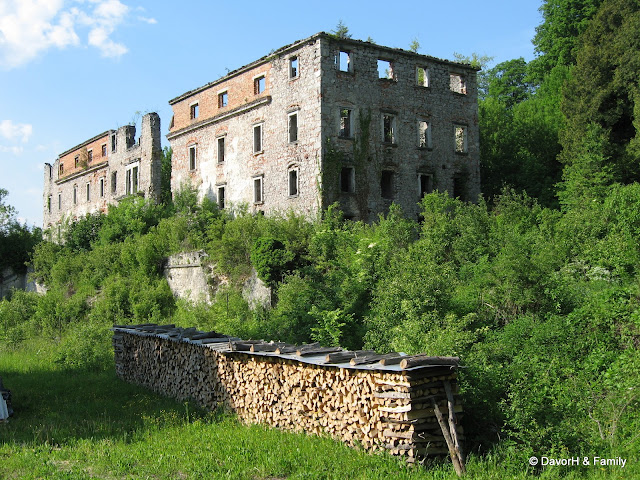
(English) (Fotografije / Photos) (Konec teksta / End of Text)
Opis
Grad Hošperk (nemško Haasberg; Hazberch) stoji v bližini Planine pri Rakeku, na uravnanem platoju nad sotesko reke Unice. Prvotni grad, od katerega so ostale le še ruševine, je stal na vzpetini nad Planino. Grad je imel več imen; pojavlja se kot Alben, pa kot Haasberg, kar pomeni Zajčja gora, in kot Stari grad. Prvič se omenja leta 1295 kot grad Unec (castrum Moevntz).
Ožje območje Hošperka je bilo pred prvo omembo v posesti grofov Goriških. Pridobili so ga najbrž s poroko grofa Engelberta III z Matildo, hčerko grofa Majnharda Črnograjsko-Šumberško-Ortenburškega. Pripadajoča zemljiška posest je izvirala iz posesti rodbine Weimar-Orlamünde, deloma pa je bila nekoč oglejski fevd. Grad Hošperk je najbrž nastal do konca 12. stoletja na dominantni, 703-metrski vzpetini nad Uncem, kjer je bilo najdenih več predmetov iz halštatske in rimske dobe. Varoval je križišče cest proti Logatcu, Ljubljani, Cerknici in na Kras in pomembno mitnico. Grad je bil v srednjemveku pomembna obrambna postojanka, ki je varovala izjemno pomembno križišče, kjer se t.i. »patriarhova pot«, ki prihaja čez Bloke in Cerknico, priključi »ljubljanski« ali »kraški« cesti v Gorico oziroma Trst. Da je bil tu grad postavljen že v 12. stoletju, kaže na to, kako pomembno in trgovsko živahno je bilo to križišče že v prejšnjih stoletjih. Poleg Goriških so imeli tam fevde tudi gospodje z Devina, ki so jih leta 1307 prodali kranjskemu vicedomu Henriku Gralantu, njegova vdova Elizabeta (roj. Rihemberška) pa leta 1333 grofom Goriškim, med drugim tudi »daz purchstal und den perch der da haizzet der Hazperch«. S tem se je tamkajšnja goriška posest zaokrožila. Grad so upravljali številni kastelani in fevdniki Goriških grofov, med njimi vitezi Albenski iz rodbine Neuhausov. V 14. stoletju (prvič omenjen 1307) v virih najbolj izstopa kastelan Renzo, ki se leta 1321 ter nato še leta 1330 in 1332 omenja kot »dominus Renc miles de Alpibus«. Bil je ugleden vitez, po izvoru iz Novega gradu na Notranjskem (Podgrad pod Brkini) ter brat Witiga Bogatca, poročen s hčerjo Hermana z Viševka. Pred letom 1373 je bil gradiščan neki Herman, med letoma 1375 in 1377 je omenjen neki Konrad Muracher z Landecka na Tirolskem, leta 1409 pa se omenja Gilg Gallenberger z Osterburga. Leta 1435 so Hošperk pridobili Celjski grofje - leta 1439 se kot oskrbnik omenja Michael Reichenberger, ki ga avstrijski vojvoda Friderik opominja, naj ne nadleguje ljubljanskih trgovcev. Po izumrtju Celjskih leta 1456 pa je prešel na Habsburžane, ki so ga do leta 1587 oddajali kot deželnoknežji fevd. Med kastelani so bili Wagni in znameniti Rauberji. Leta 1511 ga je poškodoval potres in začel je propadati. Leta 1563 je grad prešel v lastništvo rodbine Windischgrätz, ko se je Sebastijan pl. Windischgrätz poročil s Katerino pl. Rauber, leta 1577 pa je bil zastavljen Juriju Hofferju.
Po letu 1614 so v ravnici pod Starim gradom Eggenbergi zgradili baročni dvorec Hošperk, ki je nekoč sodil med najlepše in najmogočnejše baročne dvorce pri nas in je dolgo časa veljal za eno najbolj reprezentativnih grajskih stavb na Slovenskem, s čudovitim parkom, katerega ostanki so vidni še dandanes. Leta 1716 je Marija Šarlota Eggenberška poleg gospostva Šteberk in Logatec Haasberg prodala Johannu Casparju Cobenzlu. Ko je leta 1810 rodbina Cobenzl izumrla, pa ga je podedoval Mihael Coronini pl. Cronberg, tj. iz Kromberka. Leta 1846 je drugič prešel v roke rodbine Windischgrätz, ko ga je kupil knez Weriand zu Windischgrätz. Ta rodbina je bila tudi njegov zadnji lastnik.
Leta 1920 so prav pri dvorcu, kjer je bila meja med Kranjsko in Goriško, začrtali mejo med Italijo in Jugoslavijo. Dvorec je bil na italijanski, prvotni grad pa na jugoslovanski strani. Pri ruševinah gradu so še vidni mejni kamni. Dvorec so med 2. svetovno vojno, 27. marca 1944 požgali partizani, takrat je bila popolnoma uničena dragocena notranja oprema, arhiv rodbine ter družinska grobnica Windischgrätzov. Kljub nekaj poskusom, da bi dvorec obnovili, pa je to do danes ostalo le pri idejah. Nekoč veličasten dvorec je vsa ta leta nezadržno propadal in verjetno tudi že dokončno propadel. Danes je v ruševinah, prekrit z rastlinjem in obraščen z drevjem.
Dostop
Ruševine stojijo na Planini nasprotni strani kraškega Planinskega polja. Do njih je dostop možen s stare magistralne ceste Ljubljana – Koper, kjer v Planini sledite smerokazom za Cerknico, ali pa z avtoceste Ljubljana – Koper, ki jo zapustite na izvozu Unec in se usmerite desno proti Planini. Parkiranje je možno v neposredni bližini ostankov gradu (točka PARK).
Dostop do gradu je mogoč skozi celo leto, z možno izjemo dni, ko je Planinsko polje poplavljeno do te mere, da preplavi cesto z obeh strani. To se zadnje čase dogaja le vsakih nekaj let. Dostop do zaklada pa je mogoč vedno, ko je možno priti do gradu, odsvetujemo le dneve z visokim snegom, saj je takrat gibanje tam oteženo.
OPOZORILO: Ruševine gradu so nevarne, zato je tvegano in tudi prepovedano hoditi med njimi! Da bi našli ta zaklad, ni potrebno izzivati usode in hoditi v neposredni bližini ostankov dvorca.
Zaklad
V zakladu je poleg knjižice vpisov še nekaj manjših predmetov za menjavo. Svinčnika ni, zato ga prinesite s seboj.
Velike nevarnosti za srečanje z nepoklicanimi obiskovalci ni, vseeno pa velja biti pri iskanju zaklada previden. Prosimo tudi, da zaklad dobro skrijete, da ne bo padel v oči kakemu bunkeljnu.
(Začetek teksta) (Fotografije) (Konec teksta)
(Slovene) (Photos) (End of Text)
Description
The Hošperk Castle (German Haasberg; Hazberch) is located near the village of Planina, on a flat plateau above the channel of the river Unica. The original castle, of which only ruins remain to these days, stood on a hill above Planina. The castle has had many names, e.g. Alben, Haasberg (which means Rabbit Mountain), and Old Castle. It was mentioned for the first time in 1295 as the Unec castle (Castrum Moevntz).
Before it was mentioned for the first time, core area of Hošperk was in the possession of the Counts of Gorica. They probably acquired it by the marriage of Count Engelbert III to Matilda, daughter of Count Meinhard of Ortenburg. The rest of the estate originated mostly from the Weimar -Orlamünde family and in part it was formerly a fief of Aquileia. The Hošperk castle was probably built by the end of 12th century on top of the dominant, 703-meter hill above Unec, where several items from the Hallstatt and Roman periods were found. It guarded the intersection of roads to Logatec, Ljubljana, Cerknica and the Karst and important toll-house. The castle was in the Middle Ages an important defense outpost, which guarded an extremely important crossing, where the "Patriarch path" that comes from Bloke and Cerknica, joins "Ljubljana" or "karst" road to Gorica (Gorizia) and Trst (Trieste). The fact that the castle was erected here in the 12th century shows how important and busy that intersection was in previous centuries. Apart from Counts of Gorica also noblemen from Devin (Duino) had their estate in the area. In 1307 they sold it to Henry Gralant from Kranj, and in 1333 his widow Elizabeth (b. Rihemberk) sold it to Counts of Gorica, including "daz purchstal und den der perch to haizzet der Hazperch ", thus rounding their estate. The castle was handled by a number of castellans, among them the Knights of Alben from the Neuhaus family. In the 14th century (first mentioned in 1307) castellan Renzo stands out in historic sources. In 1321 and then in 1330 and 1332 he was referred to as "dominus Renc miles de Alpibus ". He was a renowned knight, originating from the Novi grad in Notranjska region (now Podgrad in the Brkini region), and brother of Witigo Bogatec, married to the daughter of Herman of Viševek. Other castellans include certain Herman before 1373, Konrad Muracher of Landeck in Tyrol between 1375 and 1377, and Gilg Gallenberger from Osterburg in 1409. In 1435 Hošperk was gained by the Counts of Celje - in 1439 Michael Reichenberger is mentioned as a caretaker, being warned by the Austrian duke Frederick not to hassle merchants from Ljubljana. After the demise of Counts of Celje in 1456 the castle went to the Habsburgs, who until 1587 rented it out as a provincial fiefdom. Among castellans during this period were Wagnas and famous Raubers. In 1511 the castle was damaged in an earthquake and began to deteriorate. In 1563 it became owned by the Windischgrätz family when Sebastian pl. Windischgrätz married Katerina pl. Rauber. In 1577 it was hocked to Jurij Hoffer.
After 1614, in the plain below the Old Castle the Eggenberg family built a baroque mansion Hošperk that once was one of the most beautiful and mightiest baroque palaces in what is now Slovenia. For a long time it has been one of the most representative castles in Slovenia, with a beautiful park, remains of which are still visible today. In 1716, Mary Charlotte Eggenberg sold Haasberg together with Šteberk and Logatec estates to Johann Caspar Cobenzl. When in 1810 family Cobenzl became extinct, it was inherited by Michael Coronini pl. Cronberg. In 1846, the castle went into the hands of the Windischgrätz family for the second time when it was bought by Prince Weriand zu Windischgrätz. This family was also its last owner.
In 1920, right at the mansion, where the border between Gorica and Kranjska regions used to be, the border between Italy and Yugoslavia was set. The mansion was on the Italian, the original castle on the Yugoslav side. Border stones are still visible at the ruins of the castle. During WWII, on 27th of March 1944, partisans burned down the mansion and fire completely destroyed valuable furnishings, family archives and Windischgrätz family crypt. There were several attempts to restore the mansion but they didn't move any further from the ideas. Once magnificent mansion has all these years steadily decayed and has probably come beyond the point of repair. Today it is nothing but the ruins, covered with vegetation.
Access
The castle ruins stand on the eastern side of Planina karst field, on the opposite side of Planina. One can get to the location from the old road Ljubljana - Koper, where in Planina the signs for Cerknica should be followed, or from the highway Ljubljana - Koper, which one should leave at exit Unec and turn right towards Planina. There is ample parking space in the vicinity of the castle remains (waypoint PARK).
Access to the castle is possible throughout the year, with the possible exception of days when the Planina field is flooded to such an extent that water floods the road on both sides. This is recently happening only every few years. Access to the cache is possible whenever it is possible to get to the castle, we only advise against it during high snow when moving around can get difficult.
WARNING: The ruins of the castle are dangerous, so it is risky and forbidden to walk between them! To find this cache, it is not necessary to induce fate and walk near the remains of the manor.
Cache
There are a few small items for trade in the cache. There is no pencil in the box so bring your own.
It is not very likely to come across muggles, but caution is still advisable. Hide the cache well afterwards to avoid some muggle finding it.
(English)
Viri / Sources
- Wikipedija / Wikipedia
- Starodobnik
Slike / Photos (Preskoči / Skip)
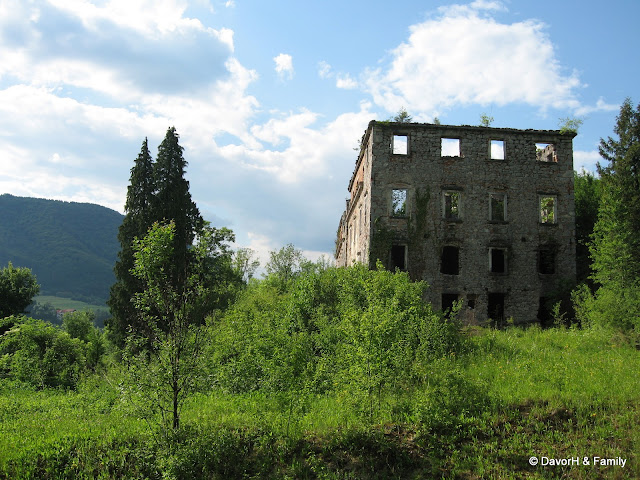
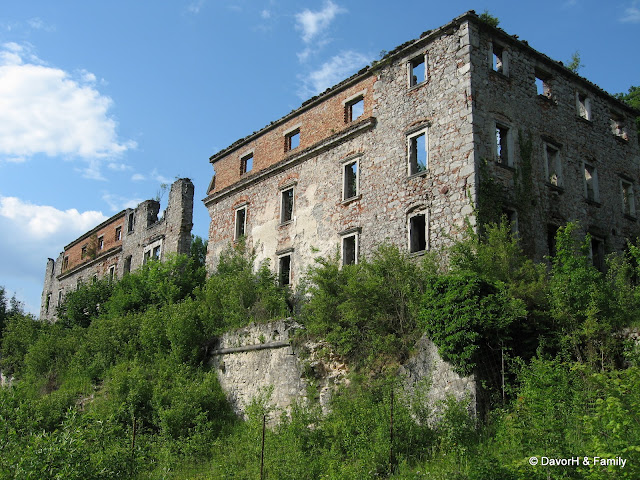
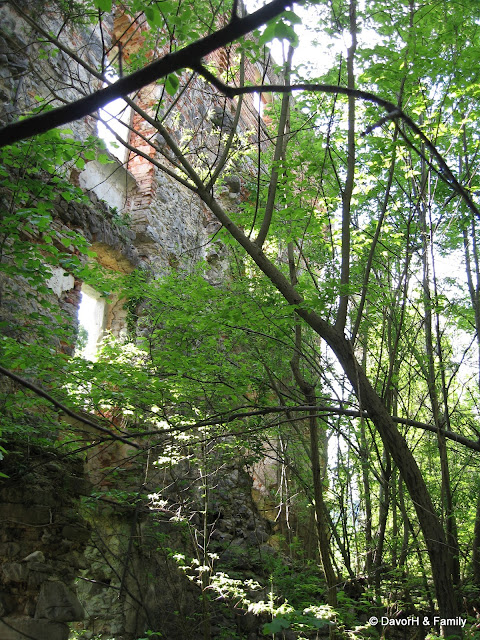
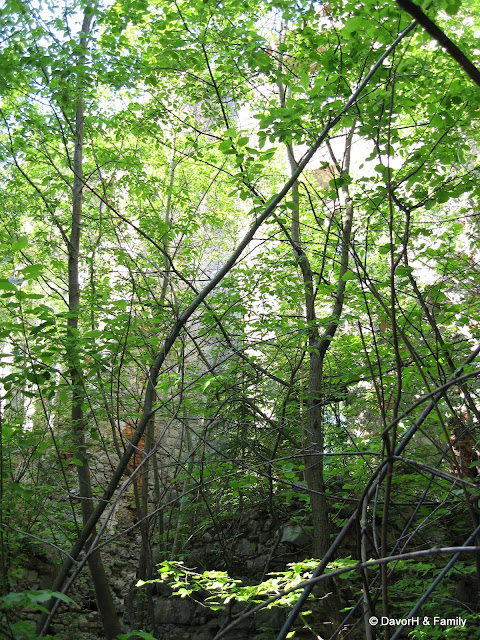
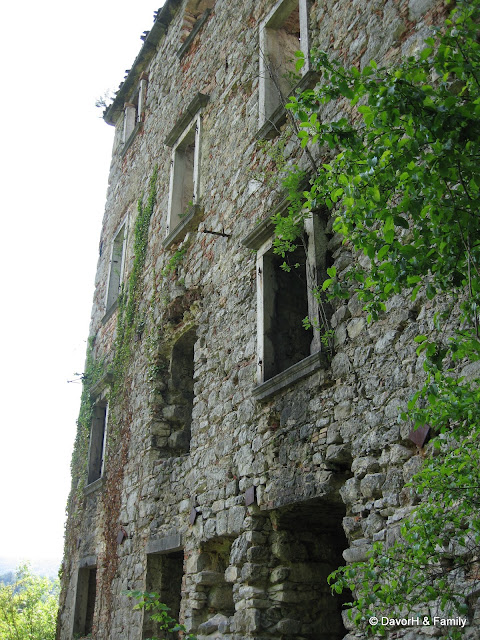
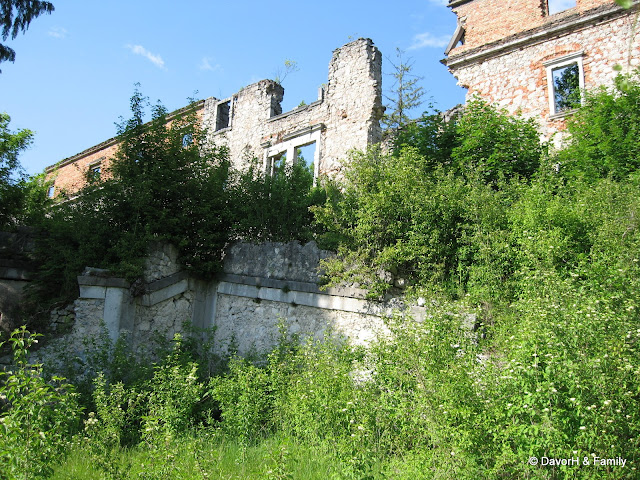

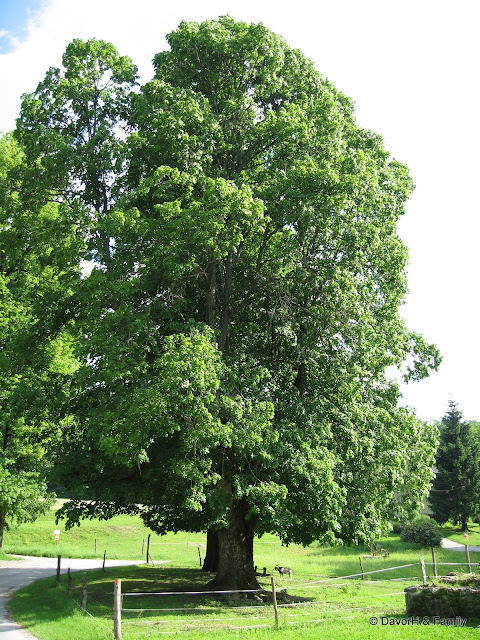
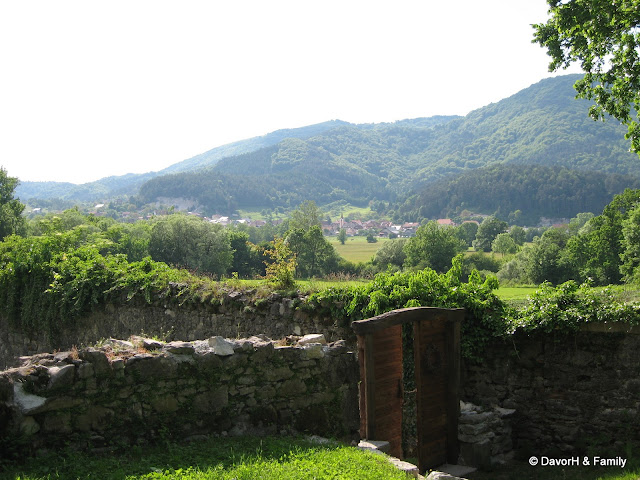
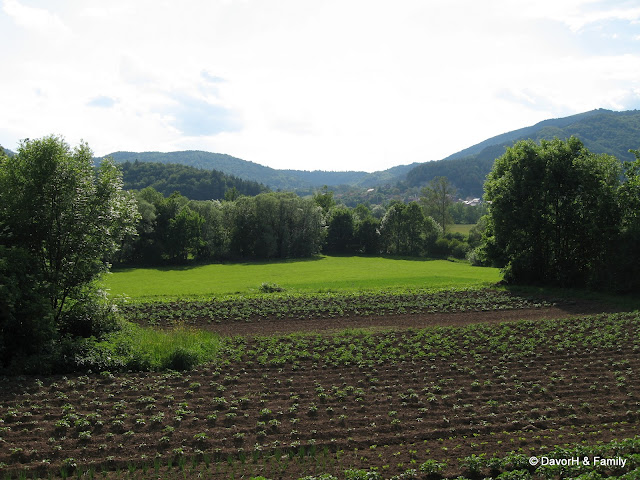
(Vrh / Top)